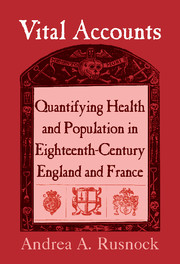Book contents
- Frontmatter
- Contents
- List of Illustrations
- Acknowledgments
- Vital Accounts
- Introduction
- 1 A New Science: Political Arithmetic
- PART ONE SMALLPOX INOCULATION AND MEDICAL ARITHMETIC
- 2 A Measure of Safety: English Debates over Inoculation in the 1720s
- 3 The Limits of Calculation: French Debates over Inoculation in the 1760s
- 4 Charitable Calculations: English Debates over the Inoculation of the Urban Poor, 1750–1800
- PART TWO MEDICAL ARITHMETIC AND ENVIRONMENTAL MEDICINE
- PART THREE POLITICAL ARITHMETIC
- Conclusion
- Bibliography
- Index
- Titles in the series
4 - Charitable Calculations: English Debates over the Inoculation of the Urban Poor, 1750–1800
Published online by Cambridge University Press: 15 October 2009
- Frontmatter
- Contents
- List of Illustrations
- Acknowledgments
- Vital Accounts
- Introduction
- 1 A New Science: Political Arithmetic
- PART ONE SMALLPOX INOCULATION AND MEDICAL ARITHMETIC
- 2 A Measure of Safety: English Debates over Inoculation in the 1720s
- 3 The Limits of Calculation: French Debates over Inoculation in the 1760s
- 4 Charitable Calculations: English Debates over the Inoculation of the Urban Poor, 1750–1800
- PART TWO MEDICAL ARITHMETIC AND ENVIRONMENTAL MEDICINE
- PART THREE POLITICAL ARITHMETIC
- Conclusion
- Bibliography
- Index
- Titles in the series
Summary
Every life saved by this practice is so much solid treasure and strength added to the nation.
William Black (1781)During the 1750s and 1760s in the county of Suffolk, the English surgeon Robert Sutton developed a new inoculation technique that produced a milder case of smallpox and greatly reduced the risks of dying. Instead of making a deep incision, Sutton made a very slight puncture. His son, Daniel Sutton, followed his father's practice and popularized the new procedure. “The lancet being charged with the smallest perceivable quantity (and the smaller the better) of unripe, crude or watery matter,” Daniel Sutton explained, “immediately introduce it by puncture, obliquely, between the scarf [epidermis] and true skin [dermis], barely sufficient to draw blood.” Daniel Sutton became a prolific inoculator and cultivated the practice of general inoculations, where all the inhabitants of a small town or village would be treated at once. He and his partners claimed to have inoculated 55,000 persons between 1760 and 1767, “of which number six only died.”
When inoculation was first introduced in England, physicians and surgeons had interpreted the practice in humoral terms and deemed it necessary to prepare an individual for the procedure. For up to a month prior to the actual incision, the patient would be bled, purged, and put on a low diet.
- Type
- Chapter
- Information
- Vital AccountsQuantifying Health and Population in Eighteenth-Century England and France, pp. 92 - 106Publisher: Cambridge University PressPrint publication year: 2002



